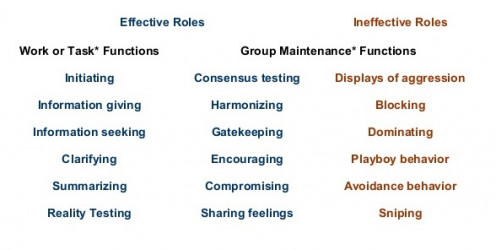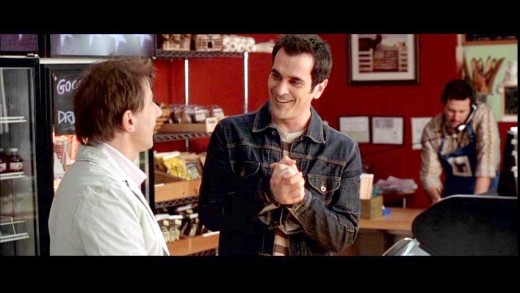Organizational Behavior Series: #2 Group Formation

What can managers learn from a couple of friends in a coffee shop? Well, if analyzing these two with a Task and Maintenance Function rubric, then, quite a bit! Although supporting characters in the 2006 film, Friends with Money, Ty Burrell and Simon McBurney delivered an excellent performance in their roles as two awkward acquaintances. This article follows the development of their relationship through an OB (organization-behavioral) lens. Let's watch, as this unconventional group takes shape.

Concepts to Explore
Group Cohesion
| Stages of Development
| Task and Maintenance Functions
| Social Benefits
|
|---|---|---|---|
As the relationship progresses, a clear chemistry develops between the two; they communicate very freely. The group reaches a climax when one says that guys generally think he’s hitting on them, but the other reassuringly says that he feels comfortable.
| After an awkward introduction and a few introductory questions, the group normed and began performing activities together. They may have adjourned in a limited sense after each activity, but we don’t see them adjourning permanently.
| They performed small tasks to facilitate their activities together, such as seeking information so as to know if they should get something to eat, and worked to maintain an amiable relationship.
| Psychological intimacy was gained in the group, evidenced especially later on in the film as they admitted that they felt very comfortable in each other’s presence.
|
Task and Maintenance Functions

Forming
In the group that will be examined in this article, one of the members seemed particularly interested in achieving psychological intimacy – emotional and psychological closeness to other team or group members. In order to achieve psychological intimacy, a group must effectively employ two sets of functions while working together: task functions and maintenance functions. The second Aaron (the clothing designer), played by Ty Burrell, adroitly used both sets of these functions throughout their time spent together, and seemed to successfully help his group develop the psychological intimacy that he apparently desired. When addressed below, the task and maintenance functions illustrated by the characters will be emboldened and italicized.

From the moment he began to interact with the first Aaron (Simon McBurney) in the coffee shop, he wasted no time initiating activity for the nascent group to engage in. He starts by initiating conversation. Burrell's "Aaron" comments that he sees the other gentleman in that shop a lot. “Yeah … I just work up the street,” the first Aaron mutters before turning back around. But Ty Burrell’s character would not be deterred. He seeks further information about his new acquaintance. At this point, the character played by Simon McBurney may be becoming a bit uncomfortable. To maintain this growing interpersonal relationship, the second Aaron does what could be considered tension reduction: he shows personal interest his compadre, asking about his work, even moving closer to him as if to show that he was just another one of the first Aaron's friends and that this was just an informal, casual conversation. It works; his new acquaintance starts to open up and a congenial conversation ensues.
Storming, Norming, and Performing

To keep the conversation going, the second Aaron’s new acquaintance engages in gatekeeping, turning the conversation back to his comrade, who then gives information about his own work. And their relationship continues to develop. We are not shown which Aaron initiated their trip to the movies, but the second Aaron coordinated the group’s subsequent activity: a meal at his home, his friend following his lead. He made the suggestion, prepared the meal, and, once finished, led the group outside. While conversing, Aaron’s friend asks if Aaron has children, to which he tersely says, “No,” (without elaborating), and then turns the question back to his friend. Was this question too personal? Perhaps Aaron wanted to set a boundary – a standard – for the group at this point. His friend tests him, asking a probing auxiliary question, ‘Was that a conscious decision?’ He may have been attempting to diagnose a potential problem in the group’s relationship, something that could prevent them from becoming closer friends. The group’s potential conflict is avoided, however, as Aaron opens up about his marital issues, thus harmonizing the group. Instead of hitting a brick wall, the group actually becomes more cohesive, with Aaron expressing very private feelings. Thus, as this segment ended, Aaron seemed to have gained the affection and warmth, unconditional positive regard, opportunity for emotional expression, openness, security and emotional support, and giving and receiving of nurturance (important aspects of psychological intimacy) that he felt he was lacking with his wife. Indeed, even after apologizing for possibly giving too much information, his friend reassured him that everything was fine and that he actually felt very comfortable around Aaron – truly an example of “unconditional positive regard”. Gaining psychological intimacy can result in improved health, and Aaron appeared to be in lighter spirits as he became better friends with the other Aaron.

Task functions are activities directly related to the effective completion of the team’s work. The two characters were not actually engaged in a work project, so the task functions listed above would have to be applied more so in principle than as concrete examples. It is mainly maintenance functions that enhance togetherness, cooperation, and teamwork, enabling members to achieve psychological intimacy. The group could be said to have had the informal “goal” of engaging in mutually enjoyable activities together, and that they performed several smaller “tasks” such as conversing in the café, going to the movies, and sharing a meal together to help them achieve that goal. In these cases, the task functions could be thought of as the actions they took to directly carry out their tasks (such as initiating their first conversation or seeking to know if Aaron was hungry and coordinating the meal), while the maintenance functions could refer to their interactions with each other as they carried out their tasks. Aaron coordinated the meal – arranging it and preparing it (task function), and expressed feelings about decorating (maintenance function) while cooking. Again, applying task functions to an informal group could be a bit of a stretch, so it may be better to apply the task functions mentioned above to the film by extension rather than directly.
Social Benefits
From the moment we are introduced to Ty Burrell’s character in Friends with Money , the viewer can infer that he may have been experiencing feelings of emotional isolation and loneliness – apparently because of a souring relationship with his wife. He also owned his own sock company. We do not know how many, if any, other persons worked with him, but feelings of isolation and loneliness can be especially problematic for individuals in higher positions within a company. Psychological intimacy need not necessarily be achieved in the work setting, and the viewer saw that illustrated in Aaron’s case as he turned neither to work nor his home life for a fulfilling social relationship, but to a casual acquaintance that he regularly bumped into in his day-to-day life. Observing a scene of the lonely Aaron while designing a new product or a clip of him having a discouraging interaction with an unattached or irascible wife could help the viewer to see the power that maintenance functions can have in sustaining a group – and the effect that a lack of such functions can have on the group. The further up in an organization one goes, the more difficult it can be to feel a sense of camaraderie with any of one’s workmates (since there are less workmates to have camaraderie with, less peers). Thus, there is less opportunity to be up-built and encouraged or to form close bonds. If one considers a marriage to be a group or a team, it could be enlightening to see which maintenance functions a poor marriage is lacking. In Aaron’s case, was there a dearth of support? Was there balanced communication? If one of them was the understood leader (it may not have been Aaron (I say this tongue-in-cheek)), did the other follow along? Did they reaffirm any consensus they may have had, perhaps getting unstated feelings out into the open? Did they really want to harmonize any conflict they may have had? Maintenance functions further the success of the team. No doubt, several poorly executed or entirely absent maintenance functions in Aaron’s marriage could have been pointed out had this article examined an interaction between himself and his wife. This more comprehensive view of Aaron’s life could have depicted even more clearly the influence that psychological intimacy – or a lack thereof – can have on a person.

What Do You Think?
Are films an effective medium for exploring psychological, linguistic, philosophical, moral, literary, and artistic concepts?
References
- IRVIN SUMMERS, TERRY COFFELT, and ROY E. HORTON (1988) WORK-GROUP COHESION. Psychological Reports: Volume 63, Issue , pp. 627-636.
- ANCONA, DG,CALDWELL, DF. (1988). BEYOND TASK AND MAINTENANCE - DEFINING EXTERNAL FUNCTIONS IN GROUPS. GROUP & ORGANIZATION STUDIES, 13(4), 468-494.
- Nelson, Debra., Quick, J. (2013). Organizational Behavior: Science, the Real World, and You (8th edition). Mason, OH. Southwestern Cengage-Learning.
- Caple, R. B. (1978). The sequential stages of group development. Small Group Behavior, 9(4), 470-476.







